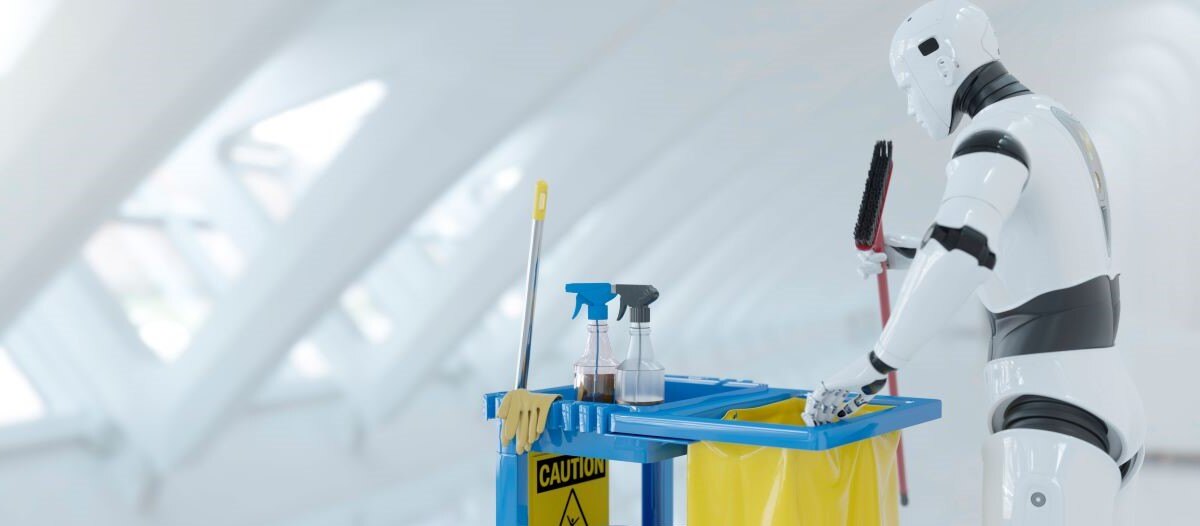Rethink Staffing Strategy
Implementing robotic cleaners

Facility managers face a growing number of complicated hurdles in their quest to efficiently and responsibly steward their organization’s operational strategy. Cost pressures are pushing them to do more with less; while growing calls for sustainable operations place top-level decision-making under a microscope. Meanwhile, persistent labor shortages make the essential task of providing customers and employees a safe and clean workplace extraordinarily difficult — sometimes to the extent that core responsibilities simply do not get done.
In response to these factors, FMs are turning to autonomous mobile robots as a means of delivering better results and reducing costs. But while autonomous cleaning can support both of those goals, the adoption of robotic cleaners is not a one-size-fits-all endeavor. FMs who fail to take a thoughtful change management approach risk undermining the gains in efficiency this technology has the potential to provide.
Specifically in staffing and employee management, cleaning robots give FMs the opportunity to fundamentally reframe how work gets done. Robotic cleaners have the potential to empower core staff and drive a FM strategy that hinges on proactive engagement (as opposed to simply reacting to new problems as they arise). With the right approach, FMs can use autonomous cleaning to strengthen every part of their workforce.
Shortages and opportunities: The rise of robotic cleaning
Various market pressures are contributing to the rise in adoption of robotic cleaning. The most salient are those pressures are undoubtedly the stubborn challenge of hiring and retaining qualified, experienced cleaning labor. This challenge boils down to four core issues:
- Availability: FMs find themselves struggling to hire a full team with whom they can entrust core cleaning responsibilities — the stuff that really needs to get done on a daily basis.
- Reliability: These shortages can create more painful effects downstream. For example, when existing personnel are tasked with maintaining full-staff standards with a partially staffed team, they tend to reach a breaking point and burn out.
- Cost: Putting too much pressure on current high-value employees tends to turn them into ex-employees, which contributes to ballooning costs related to hiring and training.
- Quality: While FMs struggle with this negative feedback loop, the quality of their on-the-ground maintenance risks falling to unacceptable levels.
Meanwhile, customer expectations are rising when it comes to cleanliness, which has amped up the pressure to keep facilities spotless. The average cleaning company loses up to 55 percent of its customer base every year due to poor service, according to a study by Franchise Help. But more intensive and complex cleaning measures — for example, cleaning the floors more than once daily, increasing the frequency of high-touch surface disinfection, etc. — put FMs in the position of trying to meet a growing set of demands with a dwindling set of resources. Countless FM professionals are incredulous over how, exactly, they are supposed to get everything done.
Robotic cleaning can be an indispensable tool in solving this problem across a wide array of value metrics. Modern cleaning robots can operate autonomously using sensors, controllers, and software that keeps FMs in the loop with up-to-the-moment cleaning data. Many of the newest models are surprisingly compact yet powerful, capable of holding high volumes of cleaning solution and can run for hours on end.
Strategic realignment, not replacement
From a cleaning perspective, cleaning robots increase both cleaning efficiency and consistency, while also giving FMs a new level of real-time performance data that delivers remote quality assurance. And from a labor management perspective, cleaning robots fill in labor gaps while also freeing up your team members to focus on more high-value and rewarding responsibilities as opposed to the same cycle of everyday, monotonous cleaning tasks.
This last point is worth lingering on. It is tempting to think of robotic cleaning exclusively within a replacement paradigm — as in, “These robotics will replace my full-time staff of workers.” This mindset not only ignores the full and enduring value of hands-on cleaning labor, but it also fails to recognize how robotics can support human labor toward an overall gain in efficiency and thoroughness.
Cleaning robots enable the strategic realignment of labor resources, empowering FMs to work alongside their staff in developing better operational procedures that meet (or even exceed) the expectations that customers bring to the table. In a moment where these high customer expectations are increasingly a board-level concern, cleaning robots help FM teams demonstrate how their operational expertise can serve as an integral, high-impact component of proactive business strategy.
A new approach to staffing
Of course, existing employees may not initially have such an optimistic view of robotic cleaning. For loyal workers who have been cleaning for years, it is reasonable to have a little anxiety over the prospect of a robot “taking my job.” But that simply is not the case, and it is important for leadership to authoritatively drive that point home.
That is why to achieve the highest levels of success in the adoption of cleaning robots, facility managers must develop strong communication and change management plans. These are some tips FMs can use to demonstrate good leadership during their automation transition:
-
Explain how cleaning robots supplement human labor (as opposed to replacing it). Make it clear that cleaning robots allow them to spend more time on high-value tasks that only humans can do and use this opportunity to emphasize their importance to the organization. Some facilities opt to use the language of “co-bots” — that is, robotic cleaning machines designed to work alongside employees.
-
Highlight the burdens that will be alleviated by cleaning robots. Floor cleaning is tedious work, and longtime cleaning staff are acutely aware of this. Show staff how robotic floor cleaners will free them from that monotony and allow them to focus on more complex and engaging responsibilities that strengthen their ties to the organization’s core goals.
-
Frame the adoption of robotic cleaning as an opportunity. Robotics are quite simply the future — in FM and other industries. By beefing up their knowledge of robot training, maintenance, and operation, employees will be upskilling themselves in a highly relevant area and therefore participating in meaningful career development.
-
Emphasize that robotic cleaners can also be a differentiator for the facility. Adopting new technology gives FMs an opportunity to strengthen the company’s image as a progressive, tech-savvy, future-ready organization. Robotic cleaners arm leadership with data that validates performance –– something they can use to underscore the organization’s successful and confident path forward.
By embracing these foundational elements of strong change management, FMs can assuage the concerns felt by their staff while also preparing the organization for a full and enthusiastic embrace of autonomous cleaning. This change in management work also positions the organization for a revised approach to staffing — one that accounts for the new allocation of cleaning responsibilities within a hybrid human/machine workforce.
Taking this expansive approach to communicating with new and existing employees ensures FMs will gain the highest levels of collaboration and tech-empowered productivity out of their workforce. Especially now, when labor shortages are complicating the most essential FM tasks, this boosted level of employee engagement is priceless.
How to implement robotic cleaning successfully
To help organizations adopt cleaning robots, FMs should focus on collaborating with their team in three key areas: facility preparedness, transition management and staff training.
- Prepare the facility for success. FMs must develop a plan for integrating robotic cleaning with other processes to optimize efficiency. Managers and their staff can prepare their facility by planning and validating routes to ensure that cleaning robots can accomplish their tasks autonomously and without assistance. Additionally, the team should schedule robot cleaning around other operational processes to prevent interference with other core responsibilities. This ensures the FM team can devote their time and expertise to high-value tasks instead of frequent robot troubleshooting.
- Manage the transition for success. In addition to getting buy-in from senior leadership, FMs should delegate a site-level champion who is ready to uplevel their responsibility by taking significant ownership of robotic cleaning adoption.
This champion will take point on gathering feedback and continuously leveraging it toward improved efficiency, better use of onsite resources, and effective communication with cleaning staff. Selecting this site champion not only contributes to better outcomes; it also sends the important message that management is creating opportunities for skill development and advancement throughout the robot transition, which will lead to a more proactive and positive attitude toward working alongside cleaning robotics.
- Train the staff for success. FMs should not take a one-size-fits-all approach to their implementation of robotic cleaning. The most successful transitions are built on the foundation of meaningful employee engagement that solicits and responds to employees’ on-the-ground knowledge of day-to-day operations.
FMs should be proactive in planning how they will adjust or reschedule staff prior to even beginning robot training. Additionally, they should meet with staff to ask them about how they would most like to spend the time that will be freed up by cleaning robots. This level of thoughtful engagement makes it clear to employees that this is a genuine opportunity to play an active role in their path through the organization.
Robotic cleaners are poised to have a very real impact on how FMs staff and manage their teams, and the scope of this impact can be intimidating. But the reality is that cleaning robots have the power to create wins across the organization — from leadership to cleaning staff to end-customers. Success will depend on how strategically FMs incorporate this new technology into their operations, and how well they communicate this strategy to the key stakeholders who will determine its success.

Seth Rourke is the director of industrial products at Tennant Company. Rourke is a leader in the cleaning industry with more than 20 years of progressive marketing and product development leadership experience in premium consumer and commercial cleaning brands. He has a record of growing and building profitable offerings through needs-based customer segmentation, value-based pricing, and organizational collaboration.
Read more on Project Management , Technology and Training
Explore All FMJ Topics









